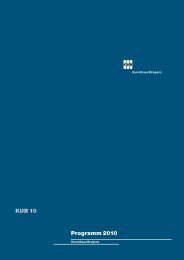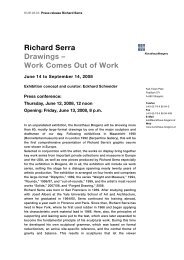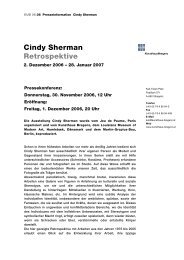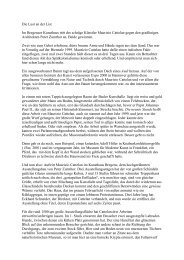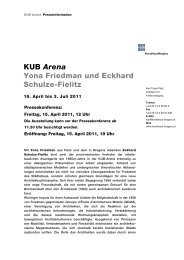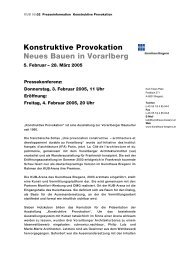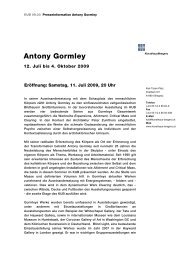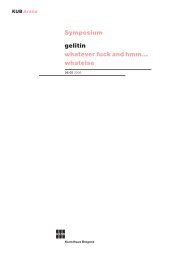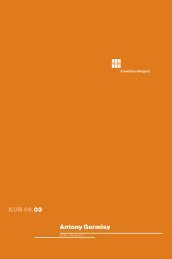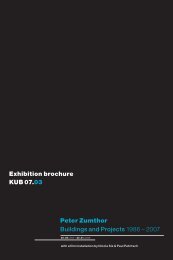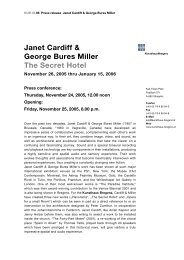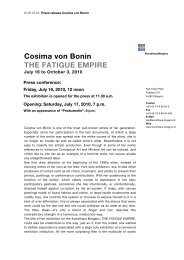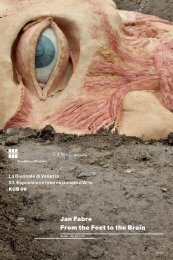Kunsthaus Bregenz . Yvonne Rainer Raum, Körper, Sprache Arena ...
Kunsthaus Bregenz . Yvonne Rainer Raum, Körper, Sprache Arena ...
Kunsthaus Bregenz . Yvonne Rainer Raum, Körper, Sprache Arena ...
Sie wollen auch ein ePaper? Erhöhen Sie die Reichweite Ihrer Titel.
YUMPU macht aus Druck-PDFs automatisch weboptimierte ePaper, die Google liebt.
<strong>Yvonne</strong> <strong>Rainer</strong><br />
After Many a Sum mer<br />
Dies the Swan, 2000,<br />
<strong>Yvonne</strong> <strong>Rainer</strong>, Sally<br />
Silvers, Emmanuèlle<br />
Phuon, Joel Reynolds,<br />
Pat Catterson, Keith<br />
Sabado, Emily Coates,<br />
Patricia Hoffbauer,<br />
Baryshnikov Dance<br />
Foundation, Brooklyn<br />
Academy of<br />
Music, nyc, C-Print,<br />
12,7 x 17,9 cm<br />
Fotograf unbekannt<br />
08 09<br />
Summary<br />
<strong>Yvonne</strong> <strong>Rainer</strong>, who is being presented by the <strong>Kunsthaus</strong> <strong>Bregenz</strong><br />
in cooperation with the Museum Ludwig in Cologne and the Getty<br />
Research Institute in Los Angeles, is one of the most vibrant art<br />
personalities of the 20th and 21st century. Born in San Francisco<br />
in 1934, <strong>Yvonne</strong> <strong>Rainer</strong> had already moved to New York by 1957<br />
to study dance with the legendary Martha Graham and the early<br />
Merce Cunningham. Her experiences with the dancer Anna Halprin<br />
and with Robert Dunn, a musician who studied under John Cage,<br />
and the friendships that she formed there with Trisha Brown, Elaine<br />
Summers, Steve Paxton, and David Gordon eventually led to the<br />
founding of the Judson Dance Theater in New York. Both personally<br />
and professionally, <strong>Yvonne</strong> <strong>Rainer</strong> already had close contact here<br />
with visual artists, some of whom such as Carl Andre, Robert Morris,<br />
or Robert Rauschenberg were involved in her dance pieces, as<br />
dancers or in some other capacity.<br />
<strong>Yvonne</strong> <strong>Rainer</strong> created surprising choreographies in which<br />
she impressively developed an entirely independent language<br />
of expression marked, among other things, by the extension of<br />
dance to include everyday gestures and activities. The scaling of the<br />
work to the human body, deliberate repetition, and the avoidance<br />
of strategies of overwhelmment are already conspicuous in one<br />
of her early works now considered a milestone of postmodern<br />
dance: Trio A (1966). Later incorporated in her evening-length dance<br />
pro gram The Mind Is a Muscle, this short work lasting only five<br />
minutes appeals on account of the reduction of its movements and<br />
the simul taneous technical prowess and understatement of their<br />
execution.<br />
In the early 1970s, <strong>Yvonne</strong> <strong>Rainer</strong> turned her back on the stage<br />
to make movies with her specific type of directorial work uniting<br />
fiction and reality, the personal and the political. Yet this did not<br />
entail turning her back on the subjects and strategies she had dealt<br />
with and implemented there. Her rejection of linear narrative and<br />
identification with actors, no less than her intellectual abstracting<br />
of emotion are also found in her films.<br />
kub 2012.01 <strong>Yvonne</strong> <strong>Rainer</strong>



